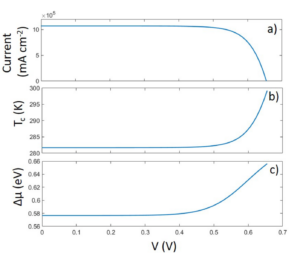Laser cooling of a semiconductor material, in which heat is extracted by emitting photons, requires a near-perfect external radiative efficiency. In this theoretical work, we propose a cooling system based on carrier extraction in a large gap reservoir. The electron-hole pairs generated in the material to be cooled are extracted in such a reservoir by absorbing phonons, then carrying a heat flux. With an analytical detailed balance model, we show that this concept is applicable even in materials with moderate external radiative efficiency. Moreover, by adjusting the gap of the reservoir to the laser power, this system can either reach high efficiency or transfer high power with lower efficiency.


Fig. 1: (left) Schematic representation of the double heterojunction. This system is made of a small gap absorber, between two reservoirs. In the whole system, the phonon temperature is set to 300 K. We do not model the cooling of the materials but only the heat fluxes. In the reservoirs, electrons are always considered at 300 K, and we apply a bias between the Fermi levels such that V = μR − μL. In our model, by solving the carriers and power fluxes conservation equations, we calculate Tc and ∆μ = μe − μh for given Eg, Ecv, V and illumination; (right) (a) Charge current density q × Jcontact, (b) carrier temperature in the absorber Tc and (c) Fermi level splitting in the absorber ∆μ, as a function of the bias V applied between the two reservoirs. Calculations are conducted for Eg = 0.47 eV, Ecv = 0.99 eV, ERE = 10−2, an illumination power of 800 W.cm−2 between Eg and Eg + 10 meV.
Ref : P. Dalla Valle, M. Bescond, F. Michelini, N. Cavassilas, “Laser Cooling in Semiconductor Heterojunctions by Extraction of Photogenerated Carriers,” Phys. Rev. Appl. 20, 014066 (2023).







